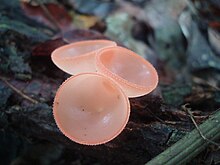Cookeina
| Cookeina | |
|---|---|
 |
|
| Cookeina sp. in Brazil | |
| Scientific classification | |
| Kingdom: | Fungi |
| Division: | Ascomycota |
| Subdivision: | Pezizomycotina |
| Class: | Ascomycota |
| Order: | Pezizales |
| Family: | Sarcoscyphaceae |
| Genus: |
Cookeina Kuntze (1891) |
| Type species | |
|
Cookeina tricholoma (Mont.) Kuntze (1891) |
|
| Species | |
|
See text |
|
See text
Cookeina is a genus of cup fungi in the family Sarcoscyphaceae, members of which may be found in tropical and subtropical regions of the world. Species may be found on fallen branches of angiosperms, trunks, and sometimes on fruits. The Temuans of Peninsular Malaysia are reported to use certain species from this genus as food, and also as a bait for fishing, where it is rubbed against the hook.
Species in the Cookeina have a deep, cup-shaped to funnel-shaped fruiting bodies, or apothecia. The inner spore-bearing surface of the apothecium, the hymenium, is brightly colored, yellow to red, although the color will fade upon drying. The outer surface is less brightly colored. The excipulum, the tissue making up the walls of the apothecium, is thin and flexible. When hairs are present on the apothecium, they are fasciculate―made of bundles of cylindrical hyphae.
The Cookeina have asci which are constricted abruptly below and form a blunt, rounded base with a slim, tail-like connection. They have asci which mature simultaneously rather than in series. They have paraphyses which anastomose and form a three-dimensional network. Ascospores are large (20—40 µm long), ellipsoidal or slightly unequal-sided, and either smooth or ornamented with fine wrinkles.
The genus appears to be restricted to wood, commonly to wood in early stages of decay.
When mature apothecia become filled with water, the asci absorb some of that water and develop a Turgor pressure, a hydrostatic pressure within the ascus which put pressure on the tip of the ascus, held in place by the rigid ascus wall. As the water level in the cup reduces due to evaporation, the asci tips dry out, resulting in a negative vapor pressure that ultimately results in the thin tissue at the wall of the apex (the operculum) breaking outward, releasing the spores.
...
Wikipedia
